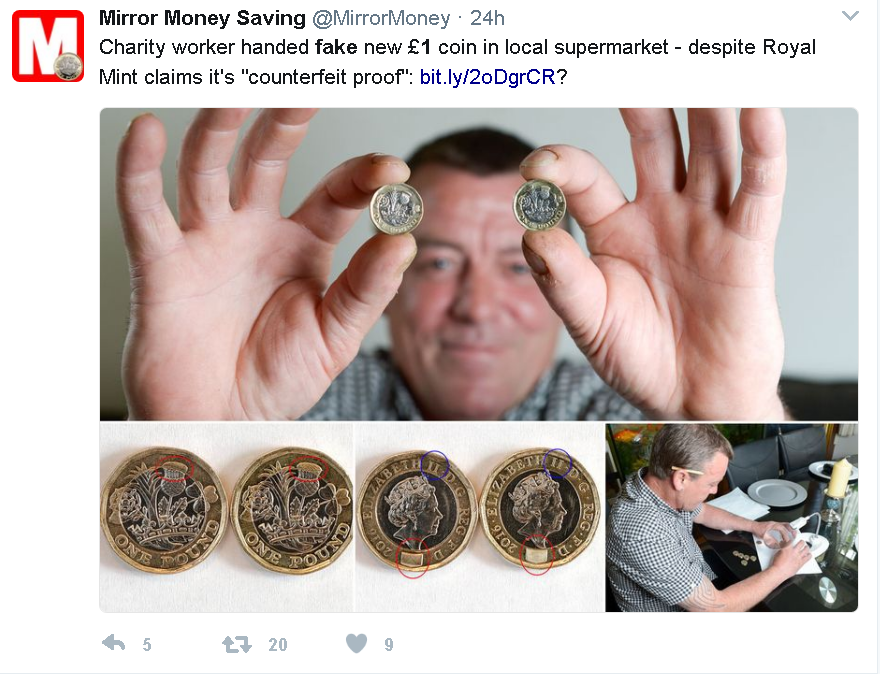Posts Tagged ‘fake’
Rumours of fake £1 coins denied by Royal Mint
The Royal Mint has denied claims that there are already counterfeit 12-Sided £1 coins in circulation after a charity worker pointed out discrepancies between two coins.
Roy Wright, a charity worker from Surrey, was shocked when he noticed a few subtle differences between the two £1 coins, leading him to believe he had found the ‘first fake £1 coin’.
Impossible to counterfeit
Despite the new £1 coins being designed to be ‘impossible to counterfeit’, Mr Wright suggested that coin he had was heavier, had no hologram and the Queen’s head was positioned more to the left. Not only that, the edges were more rounded and there was no detail on the head of the thistle.
A genuine coin with a production fault…
Whilst the story has caused some excitement in the press and The Royal Mint has not yet been able to examine the offending coin, they are confident it is not a fake, but instead a genuine coin with a production fault.
Despite tight quality controls being in place, The Royal Mint has said that variances are likely to occur during the striking process in a small numbers of coins. Whilst such mis-strikes are relatively unusual and can be numismatically interesting, they are not the same as genuine errors.
Rumours of a genuine error in circulation
Unconfirmed rumours have also been circulating about some new £1 coins featuring two dates. There are reports of some coins having 2016 on the obverse and 2017 engraved in the micro lettering of the reverse.
Although, we are yet to see an example, if this is true, it would have to be the result of mis-matched 2016 and 2017 dies being used during production – a genuine error or “mule”.
Of course, it was the use of an incorrect die that resulted in the most famous modern “error” – the “undated 20p coin“, now regarded by many as the Holy Grail of change collecting. You can read more about the story of the undated 20p here.
If you’ve #foundapound in your change, have you spotted anything strange about it?
Are these the most sophisticated fake £2 coins?
£2 coins were introduced in 1998 to prevent against counterfeiting and were the first bi-metallic coins to enter circulation in the UK.

£2 coins were first issued into circulation in 1998
Made with two different metal components, £2 coins are very complicated to manufacture and very difficult to counterfeit… or so we believed.
As we know, 1 in 30 £1 coins are fake. The Royal Mint are so concerned, they’ll be introducing a new 12-sided £1 coin in March which is billed to become the most secure circulating coin in the world.
But, this means that counterfeiters are now turning their attention to the £2 coin.
To begin with, early £2 counterfeit coins were just a lump of led tin alloy, spray painted to look like a genuine £2 coin and were easy to tell apart from the real thing.
Now, they’re becoming a lot harder to spot, even by professionals. Some fake £2 coins are even being accepted in vending machines and car parking machines.
So how many fakes are out there and who’s responsible?
Fraudsters require a highly sophisticated press to produce bi-colour coins. It’s thought that there are hundreds of thousands of fake £2 coins in circulation and is definitely a form of organised crime.
Can you spot one?
There are a few simple ways to tell if you have a fake £2 coin. One of the most obvious ways to spot a fake is by comparing the quality of the writing on the edge inscription to a genuine coin and also checking that the edge inscription matches the design.
However there are still some fake £2 coins that pass the two tests above.
According to experts, fakes can usually be detected by the weight. Genuine £2 coins should weigh 12g, but these remarkable new counterfeit £2 coins are also weighing in at 12g.
Each UK denomination is made up of different compositions which are agreed between The Royal Mint and HM Treasury but the exact amount is kept top secret.
The only way to find out for definite if the coin is real or fake is for it to be x-rayed by a special machine which gives a reading of all the different elements that have gone into the coin.
So should we be increasing the security of the £2 coins to make it harder for them to be counterfeited?
Let us know your thoughts via Facebook, Twitter or leave us a comment below.


